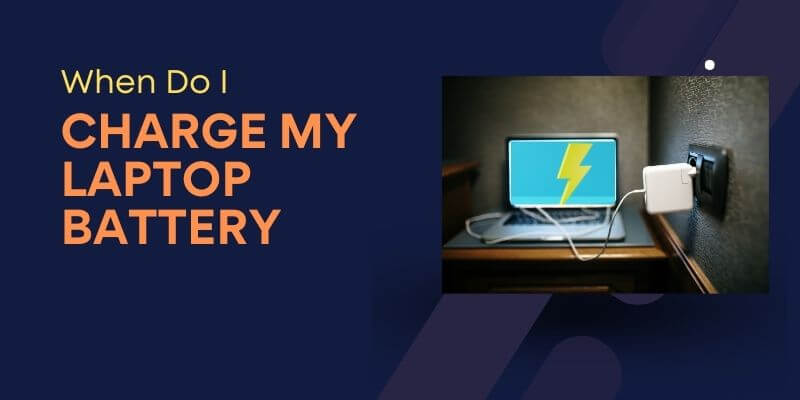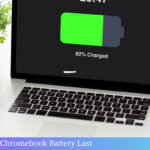Charge your laptop battery when it reaches around 20% to 30% to ensure optimal battery health and performance. Maintaining your laptop’s battery life is crucial for uninterrupted productivity and convenience.
Knowing when to charge your laptop battery is vital in enhancing its longevity and avoiding unexpected shutdowns during important tasks.
But the question arises: when is the best time to charge your laptop battery? We will provide a concise and precise explanation to help you understand the ideal charging time for your laptop battery.
By following these guidelines, you can maximize your battery’s lifespan and ensure that it performs optimally for years to come.
Let’s delve into the details of when to charge your laptop battery to keep it healthy and efficient.
Table of Contents
Understanding Laptop Battery Lifespan

Laptop battery lifespan refers to the length of time a battery can retain its ability to hold a charge.
Understanding the factors that affect laptop battery lifespan and knowing how to prolong it can help you get the most out of your device.
1. Factors Affecting Laptop Battery Lifespan
Several factors can influence the lifespan of your laptop battery. Being aware of these factors can help you make informed decisions to extend its life:
- Battery Chemistry: Different laptop batteries have varying chemistries, such as lithium-ion or nickel-cadmium. Each chemistry has a different lifespan and reacts differently to charging patterns.
- Usage Patterns: The way you use your laptop also affects its battery. Factors like frequently running resource-intensive applications, gaming, and multitasking can drain the battery faster.
- Temperature: High temperatures can significantly impact the lifespan of your laptop battery. Exposing your laptop to extreme heat can cause the battery to degrade quickly.
- Charging Cycles: A charging cycle refers to the process of fully discharging and then recharging the battery. The number of charging cycles a battery goes through affects its overall lifespan.
- Battery Age: Laptop batteries degrade over time, even if they have been well-maintained. As the battery ages, it may not hold a charge for as long as it did when it was new.
2. How to Prolong Laptop Battery Lifespan
To extend the lifespan of your laptop battery, consider the following tips:
- Optimize Power Settings: Adjust your laptop’s power settings to optimize battery usage. Lower the screen brightness and set shorter time intervals for the screen to turn off when idle.
- Avoid Extreme Temperatures: Keep your laptop in a cool environment, away from direct sunlight or other heat sources. This will help prevent the battery from overheating and degrading.
- Use Battery Saving Modes: Most laptops have power-saving modes that can help conserve battery life. Activate these modes when you are running low on battery or when you don’t require high-performance operation.
- Avoid Deep Discharges: It is best to avoid fully discharging your laptop battery frequently. Instead, try to keep the battery level between 20% and 80%. This can help prolong its overall lifespan.
- Unplug When Fully Charged: Once your laptop is fully charged, unplug it from the power source to avoid overcharging. Overcharging can degrade the battery capacity over time.
By understanding the factors that affect laptop battery lifespan and adopting good charging and usage habits, you can maximize the longevity of your laptop’s battery.
Taking these simple steps can ensure that your laptop remains a reliable and portable companion for years to come.
Best Practices For Charging Your Laptop Battery

When it comes to properly caring for your laptop battery, following the best charging practices is essential.
Not only will this help prolong the lifespan of your battery, but it will also ensure that you can get the most out of your device whenever you need it.
In this article, we will cover the optimal charging cycles for laptop batteries, how to avoid overcharging and deep discharging, and the importance of regularly calibrating your laptop battery.
1. Optimal Charging Cycles for Laptop Batteries
Understanding the charging cycles for laptop batteries is crucial in maintaining their health and efficiency.
Most laptop batteries have a limited number of full charge cycles they can undergo before their capacity starts to decrease significantly.
A full charge cycle refers to discharging the battery completely, followed by charging it back to its full capacity.
Aiming for shallow discharge cycles is recommended, where you use only a small percentage of the battery’s capacity before charging it.
By avoiding deep discharging, you can prevent unnecessary strain on the battery and extend its overall lifespan.
To achieve optimal charging cycles, charging your laptop when the battery level reaches around 20% to 30% is suggested.
2. Avoiding Overcharging and Deep Discharging
Overcharging your laptop battery can lead to decreased performance and a shortened lifespan.
Modern laptops are equipped with built-in mechanisms that prevent overcharging by cutting off the charging process once the battery reaches its maximum capacity.
However, unplugging your laptop once it is fully charged is still advisable to prevent any potential damage.
On the other hand, deep discharging, which allows the battery to drain completely before recharging, can also be harmful.
It is best to avoid letting your laptop’s battery level drop below 20% before plugging it in. Deep discharging stresses the battery and can reduce its overall capacity over time.
To ensure the longevity of your laptop battery, it is vital to establish a regular charging routine and avoid extremes in both overcharging and deep discharging.
3. The Importance of Calibrating Your Laptop Battery
Regularly calibrating your laptop battery is crucial for accurately determining its remaining capacity and extending its lifespan.
Calibration helps to recalibrate the battery’s internal power gauge, which can become less accurate over time due to usage patterns and aging.
By recalibrating your laptop battery every few months, you can ensure that the displayed battery percentage is reliable and prevent any unexpected shutdowns when the battery level seems low.
To calibrate your laptop battery, use your laptop until it powers down due to low battery. Then, plug it into a power source and allow it to charge uninterrupted to 100%.
This process helps synchronize the power gauge and the actual battery capacity, providing you with more accurate readings in the future.
By following these best practices for charging your laptop battery, you can maximize its lifespan, maintain its optimal performance, and ensure that it is always ready to power you through your work or entertainment needs.
Tips For Efficiently Using Your Laptop Battery

When it comes to maximizing the lifespan and efficiency of your laptop battery, it’s important to know the best practices for charging and using it.
By following a few simple tips, you can ensure your laptop battery lasts longer and performs at its best.
This article will explore some critical strategies for efficiently using your laptop battery.
1. Power Saving Features and Settings
Your laptop’s power-saving features and settings can significantly impact the battery life.
By adjusting these settings, you can reduce power consumption and extend the time between charges.
Here are some power-saving features and settings to consider:
- Adjust the screen brightness: Lowering the screen brightness can have a significant impact on battery life.
- Enable power save mode: Activating the power save mode can optimize power consumption by adjusting various system settings.
- Turn off or reduce keyboard backlight: If your laptop has a backlight for the keyboard, disabling it or setting it to a lower brightness level can help conserve battery power.
- Manage Wi-Fi and Bluetooth connections: Disable Wi-Fi and Bluetooth when not in use to prevent unnecessary battery drain.
2. Managing Background Processes and Battery Drain
Background processes and unnecessary applications running in the background can drain your laptop battery quickly.
By managing these processes, you can minimize battery drain and increase its overall lifespan.
Here are a few tips for managing background processes:
- Close unnecessary applications: Close any applications that you are not actively using to reduce the strain on your battery.
- Check for resource-intensive processes: Use the Task Manager or Activity Monitor to identify any resource-intensive processes that may be consuming excessive battery power.
- Disable automatic startup: Prevent unnecessary applications from starting up automatically when you boot your laptop.
- Regularly update software: Keeping your operating system and applications up to date can help optimize performance and reduce battery drain caused by outdated software.
3. Using External Power Sources Wisely
While using your laptop on the go, using external power sources wisely is vital to ensure efficient battery usage.
Here are some tips for using external power sources:
- Use the appropriate charging cable: Make sure you use the correct charging cable provided by the laptop manufacturer to avoid compatibility issues.
- Avoid overcharging: Do not leave your laptop plugged in and charging for an extended period after it reaches full capacity, as it can degrade the battery over time.
- Use high-quality power banks: If you need to charge your laptop on the go, invest in a high-quality power bank that provides sufficient power output for your laptop model.
- Keep your laptop cool: Excessive heat can negatively affect battery performance. Ensure that your laptop has proper ventilation, and avoid using it on soft surfaces that can block airflow.
By implementing these tips for efficiently using your laptop battery, you can optimize its performance, extend its lifespan, and reduce the need for frequent charging.
Incorporate these practices into your daily routine, and you’ll enjoy your laptop’s longer battery life and enhanced productivity.
Frequently Asked Questions On When Do I Charge My Laptop Battery
When Should I Plug In My Laptop To Charge?
Plug in your laptop to charge when the battery is low or when you need to use it for an extended period.
Should I Let My Laptop Battery Run Down Before Recharging?
No, letting your laptop battery run down before recharging is unnecessary.
How Do I Keep My Laptop Battery Healthy?
To keep your laptop battery healthy:
1. Unplug your laptop when it’s fully charged.
2. Avoid extreme temperatures, both hot and cold.
3. Optimize power settings to extend battery life.
4. Periodically fully discharge and recharge your battery.
Should I Leave My Laptop On Charge All The Time?
It’s not necessary to keep your laptop on charge all the time.
How Often Should I Charge My Laptop Battery?
Charging your laptop battery when it reaches around 20% to 30% of its capacity is recommended.
Is It Okay To Leave My Laptop Plugged In All The Time?
Leaving your laptop plugged in all the time can reduce the battery’s lifespan, so it is better to unplug it once it is fully charged.
Can I Use My Laptop While It Is Charging?
Yes, you can use your laptop while it is charging without any issues. However, using intensive applications may slow down the charging process.
Should I Let My Laptop Battery Drain Completely Before Charging?
Modern laptops use lithium-ion batteries that do not require complete draining. You can charge it whenever convenient without waiting for it to drain completely.
Can I Overcharge My Laptop Battery?
No, modern laptops have built-in circuitry that prevents overcharging, so you don’t have to worry about it.
Can I Charge My Laptop Overnight?
Charging your laptop overnight is not recommended as it can unnecessarily strain the battery. It is better to unplug it once it’s fully charged.
Conclusion of When Do I Charge My Laptop Battery
Understanding the optimal charging practices for your laptop battery is crucial to ensure its longevity and performance.
By following a few simple guidelines, you can maximize the lifespan of your battery and avoid potential damage.
Regularly calibrating your battery helps maintain accurate status readings, while avoiding overcharging or deep discharging can prevent capacity loss.
It is also essential to store your laptop in a cool and dry environment to prolong the battery’s life.
Additionally, using power-saving options and adjusting screen brightness can help extend battery life during usage.
Overall, being mindful of your laptop battery’s charging habits and taking proactive measures to optimize its performance will go a long way in enhancing your overall computing experience.






